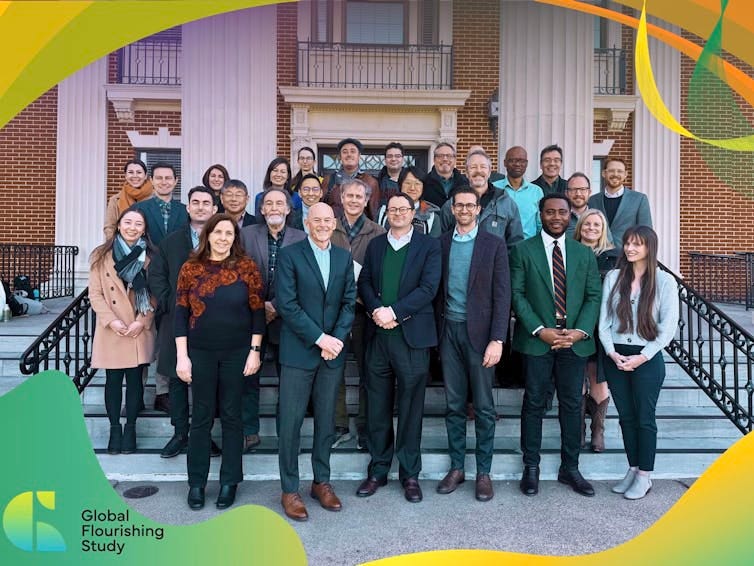What does it mean to live a good life? For centuries, philosophers, scientists and people of different cultures have tried to answer this question. Aristotle said it’s about growing in virtue and living with purpose. Positive psychology points to character strengths, strong relationships, and meaning. And the African philosophy of Ubuntu reminds us that we flourish through connection and community. Each tradition offers a different lens, but all agree: the good life is more than just feeling good — it’s about becoming whole.
More recently, researchers have focused on the idea of flourishing. It is more than just well-being and how you feel on the inside. It’s about your whole life being good, including the people around you and where you live. Things like your home, your neighborhood, your school or workplace and your friends all matter.
We are a psychological scientist, a social scientist, and an epidemiologist who are all contributors to an international collaboration called the Global Flourishing Study.“** The goal of the project is simple: to find patterns of flourishing across cultures.
Do people in some countries thrive more than others? What makes the biggest difference in a person’s well-being? Are there things people can do to improve their own lives? Understanding these trends over time can help shape policies and programs that improve global human flourishing.
What does the flourishing study focus on?
The Global Flourishing Study is a five-year annual study of over 200,000 participants from 22 countries, using nationally representative sampling to understand health and well-being. We are a team of over 40 researchers across different disciplines, cultures and institutions.
The countries included are Argentina, Australia, Brazil, Egypt, Germany, Hong Kong, India, Indonesia, Israel, Japan, Kenya, Mexico, Nigeria, the Philippines, Poland, South Africa, Spain, Sweden, Tanzania, Türkiye, the United Kingdom and the United States. With help from Gallup Inc, we asked people from these countries about their lives, their happiness, their health, their childhood experiences, and how they feel about their financial situation.
The study looks at six dimensions of a flourishing life:
Happiness and life satisfaction: how content and fulfilled people feel with their lives.
Physical and mental health: how healthy people feel, in both body and mind.
Meaning and purpose: whether people feel their lives as significant and moving in a clear direction.
Character and virtue: how people act to promote good, even in tough situations.
Close social relationships: how satisfied people are with their friendships and family ties.
Financial and material stability: whether people feel secure about their basic needs including food, housing and money.
Our study tries to quantify how participants are doing on each of these dimensions. For example, we measure happiness through questions about optimism, peace and balance in life. We measure health by asking about pain, depression and exercise. We measure relationships through questions about trust, loneliness and support.
Who is flourishing and why?
Our first wave of results is already revealing a lot. Some countries and groups of people are doing better than others. To follow are a few examples of some key things we’re beginning to learn from the flagship paper:
Young People Are Struggling
In many countries – including the U.S., Brazil, Argentina, Australia and the U.K. – young people are not doing as well as older adults. In fact, people over age 50 are often flourishing more than younger adults. That’s surprising because earlier studies suggested well-being follows a U-shape, with the lowest point in middle age. We found that flourishing was essentially flat through ages 18-49 and then increases with age, suggesting an inverted L-shape or upward slope.
These results might suggest that younger adults today are facing growing mental health challenges, financial insecurity, and a loss of meaning, disrupting the traditional U-shaped curve of well-being found in earlier studies. However, it wasn’t universal: In countries including India, Egypt and Japan, younger people still report higher levels of flourishing, while in Poland and Tanzania, flourishing decreases with age.
Marriage and Jobs Help
Being married or having a job helps people flourish. Married people usually report more support, better relationships, and more meaning in life. People who are working – either for themselves or someone else – also tend to feel more secure and happy than people who don’t have jobs.
Going to Religious Services Matters
Across many of the GFS papers, one of the strongest signs of flourishing was how often someone goes to religious services. People who go every week or more often usually report higher scores in all areas of flourishing – especially happiness, meaning and relationships. This was true in almost every country, even in very secular ones like Sweden. It seems that religious communities offer the four B’s: belonging (e.g., social support), bonding (e.g., spiritual connection), behaving (e.g., character), believing (e.g., hope).
But some people who attend religious services also report more (rather than less) pain or suffering. This may be because religious communities often provide support to people during hard times, and may thus be more likely to report experiencing grief or illness.
Childhood Matters
Your early years shape how you do later in life. People who had good relationships with their parents and felt safe and healthy as children are more likely to report flourishing as adults. But some people who had difficult childhoods – having experienced abuse or poverty – still found meaning and purposelater in life. In some places, including the U.S. and Argentina, hardship in childhood seemed to build resilience and purpose in adulthood. So even if life started off as challenging, it doesn’t mean life has to stay that way.
Men and Women Flourish Differently in Different Countries
Globally, men and women report similar levels of flourishing. But in some countries, there are big differences. For example, women in Japan report higher scores than men, while in Brazil, men report doing better than women.
Where are people flourishing most?
Some countries are doing better than others when it comes to flourishing. To follow are a few interesting examples of geography of flourishing:
Indonesia is thriving. People there scored high in many areas—like meaning, purpose, relationships, and character. Indonesia is one of the highest scoring countries in most of the indicators in the whole GFS study.
Mexico and the Philippines also show strong results. Even though these countries have less money than some others, people report strong family ties, spiritual lives, and community support.
Japan and Turkey report lower scores. Japan has a strong economy, but people there report lower happiness and weaker social connections. Long work hours and stress may be part of the reason. In Turkey, political and financial challenges may be hurting people’s sense of trust and security.
One surprising result is that richer countries like the United States and Sweden are doing okay—but not great—in some areas. They do well on financial stability but score lower in meaning and relationships. This shows that having more money doesn’t always mean people are doing better in life.
In fact, countries with higher income often report lower levels of meaning and purpose. Meanwhile, countries with higher fertility rates often report more meaning in life. These findings show that there is a trade-off. Economic progress might improve some things but weaken others.
The big picture
The Global Flourishing Study is helping us see that people all over the world want many of the same basic things: to be happy, healthy, connected, and safe. But different countries reach those goals in different ways.

The GFS data suggest that rich countries may do better with money and safety, while less wealthy countries may do better in relationships, purpose and character. There is no one-size-fits-all answer to flourishing. What it means to flourish can look different from place to place and from one individual to another.
One challenge with the GFS is that it uses the same set of questions in all 22 countries. This approach, called an etic approach, helps us compare results across cultures. But it can miss the nuance, local meanings of flourishing. For example, what brings happiness or purpose in one country might not mean the same thing in another.
That is why this study should be seen as a starting point. It opens the door for more emic research—research that uses questions and ideas that fit the values, language, and everyday life of specific cultures and societies. Researchers can build on the GFS findings to expand how we understand and measure flourishing around the world.
When we learn from one another and take both global patterns and local differences seriously, we can move closer to a world where everyone—no matter where they live—has the chance to live a fuller, more meaningful life.
An updated version of this article has been published in The Conversation.






















Share this post